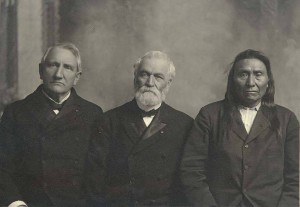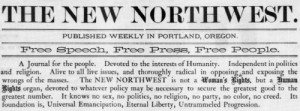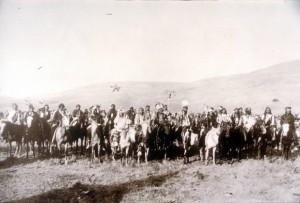
by Chandler Padgett
In the wake of the expansion of the US throughout the west, animosities flared between natives and settlers over land. The government attempted to resolve these disputes through treaties and the formation of reservations, though often the greed of settlers and dishonesty on the part of the government thwarted any chances at peace. A prime example of this is the case of the Nez Perce, who came into conflict with the US Army, known as the Nez Perce War, after a former treaty was broken by reducing their land.[1] Two accounts tell both the causes and happenings of the war itself, though they vary greatly in content. The writings, one by the Nez Perce Chief Joseph and the other by an Oregon-based suffragist Abigail Scott Duniway, mainly touch on three different causes: the settling of the land by whites, treaty disputes, and Indian attitudes.
It is a fact that the encroachment upon Nez Perce land by American settlers created the dispute in the first place, but the two sources differ in views about what role they played. Chief Joseph speaks rather extensively on the subject, saying that while they “thought there was enough room for all to live in peace,” the white men “were greedy to possess everything the Indian had.”[2] Despite the fact that he “labored hard to avoid trouble and bloodshed” and “gave up some of [his] country to the white men, thinking then that [he] could have peace,” the settlers “drove off a great many… cattle” and “would not let [them] alone.”[3] It could be said that he is biased, but he did not have much of a motive to cover up or mislead others about what happened as he had already been defeated two years prior. Therefore, his account gives great insight into the Nez Perce reaction to settlers and their defensive and originally peaceful stance regarding them, a reversal of Duniway, who portrayed the settlers as innocent—“the outbreak… is emphatically declared to be without the slightest provocation on the part of the settlers.” She is obviously biased in this claim, ignoring the wrongs perpetrated by them, likely blinded by her belief in Native American inferiority; this is depicted in her use of dehumanizing words like “savage” and “renegade.”[4] From these reports it is definite that the settlers had a role in starting the war, though whether the Indians did as well will be discussed later on.

The second factor of dispute between Americans and Nez Perce was the 1855 treaty and subsequent 1863 one that reduced the size of their land through American purchases, however shady. Duniway offers little insight into the actual discussions about land, but does reveal American opinions of the time. Ironically, in her newspaper advocating “free people,” she blames the war on “roving renegades” who refuse to “repair to the reservations designated by treaty.”[5] Chief Joseph’s account delves deeper into tricky situation that had evolved, saying that “a chief named Lawyer…sold nearly all the Nez Perce’s country” although “he had no right to sell the Wallowa country,”[6] showing that technically the US owned nothing, but due to their power and disregard of land rights, could use it as an excuse to apprehend others’ land. These two accounts illustrate why both sides believed to own the land and were angered to find others on it.

The final aspect of the conflict are the Nez Perce and their attitudes, and whether or not they instigated fights with American settlers. Duniway is quick to blame them, citing “a number of settlers” that “had been killed” and “an engagement” where “half of [Colonel Perry’s] command was killed.” Curiously enough, she adds that “this story may or may not be exaggerated,” implying that the “massacres” could have been fabricated as an excuse for war. Despite this possibility, she is nonetheless entrenched in her hatred of the natives, saying that “Indians will be true to their savage instincts,” even going so far as to recommend “extermination as the only safe and permanent treaty.”[7] Once again, Chief Joseph offers an enlightening perspective on the issue, pointing out that whites “reported many things that were false” in order to convince others that “we were going on the war path.”[8] Quite contrary to Duniway’s reports, he emphasizes repeatedly that he “did not want bloodshed”[9] and merely wanted to remain in “that beautiful valley of winding waters.” Finally, he reveals that a “young brave…whose father had been killed…had gone out…and killed four white men.” Although much less than claimed by Duniway, he was “deeply grieved” and “would have given [his] own life” to prevent it. He realizes that he was not representative of all Nez Perce however, saying “there were bad men among my people,” but defends them due to the fact that “they had been insulted a thousand times; their fathers and brothers had been killed; their mothers and wives disgraced.”[10] Despite recognizing his people’s wrongdoings, he implies that they had no other avenues to take under such pressure.
In conclusion, there seems to be ample blame on each side, which raises Chief Joseph’s question– “who was first to blame?”[11] Duniway would suggest the Nez Perce with their “threatening attitude”[12] towards innocent settlers, while Chief Joseph blames the aggressive whites and their harsh treatments of Indians mentioned above; based on the fact that Americans were the aggressors and Indians were merely reacting, it seems that the latter opinion is the correct one. Here an important distinction can be made; while Joseph realizes that there are “good white friends,”[13] Duniway generalizes the whole race of “redskins” as “savages,” [14] which is telling of many American views of the period. This distinction reveals more things about the authors themselves; while Duniway is a suffragist merely writing her opinion about news of the time, Joseph lived and experienced the war first-hand, therefore lending him much more credibility. Furthermore, if one was to use such sources in a more intensive research project, Duniway’s would be helpful to offer insight about white prejudices of the period, while Chief Joseph’s would significantly aid in understanding native opinions, beliefs, and struggles in the face of American power.
Bibliography
Duniway, Abigail. “Indian Outbreak in Idaho.” The New Northwest (Portland), June 22, 1877, accessed September 23, 2014, http://oregonnews.uoregon.edu/
Duniway, Abigail. “The Indian War in Idaho.” The New Northwest (Portland), June 29, 1877, accessed September 23, 2014, http://oregonnews.uoregon.edu/
Joseph, Chief. “An Indian’s View of Indian Affairs.” The North American Review 128, no. 269 (1879): 412-434.
[1] Chief Joseph, “An Indian’s View of Indian Affairs,” The North American Review 128, no. 269 (1879): 412-434, accessed September 23, 2014, http://digital.library.cornell.edu/.
[2] Ibid., 416.
[3] Ibid., 419.
[4] Abigail Duniway, “The Indian War in Idaho,” The New Northwest, June 29, 1877, accessed September 23, 2014, http://oregonnews.uoregon.edu/.
[5] Duniway, “Indian Outbreak”, 2.
[6] Joseph, “Indian’s View”, 417.
[7] Abigail Duniway, “Indian Outbreak in Idaho,” The New Northwest, June 22, 1877, accessed September 23, 2014, http://oregonnews.uoregon.edu/.
[8] Joseph, “Indian’s View”, 418.
[9] Ibid., 423.
[10] Ibid., 424.
[11] Ibid., 424.
[12] Duniway,” Indian Outbreak”, 2.
[13] Joseph, “Indian’s View”, 424.
[14] Duniway, “Indian War”, 2.